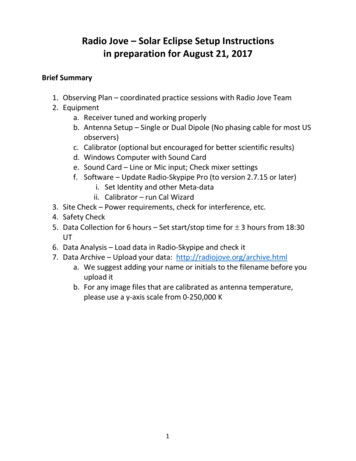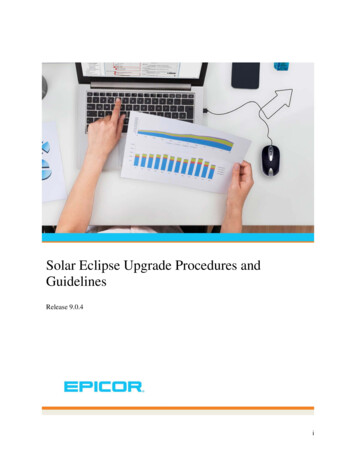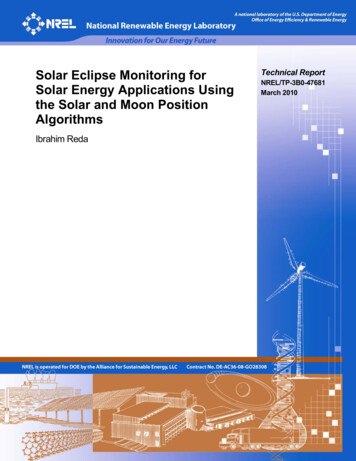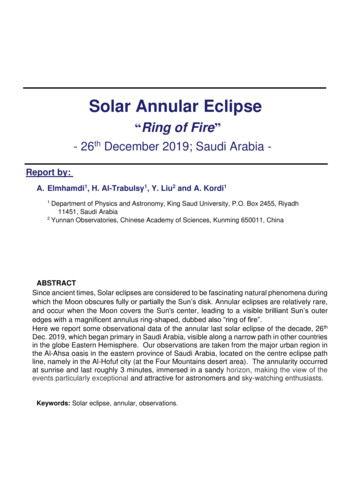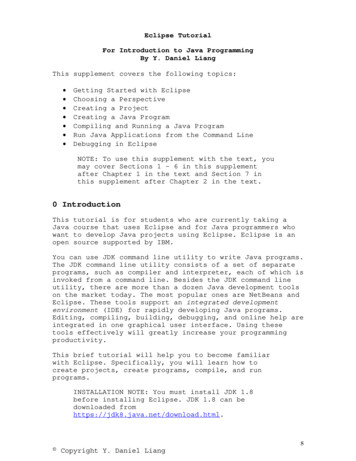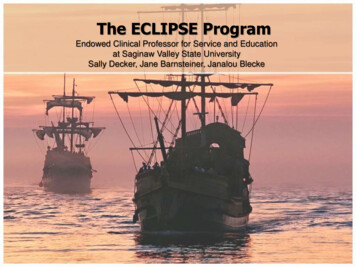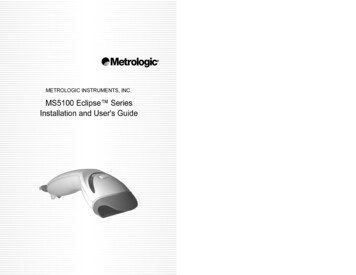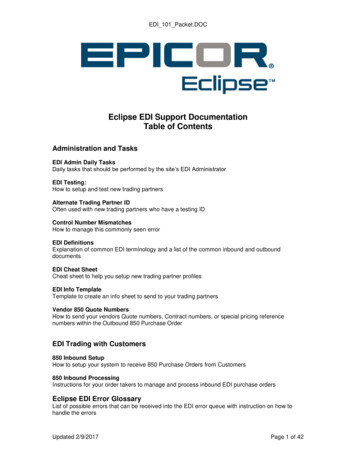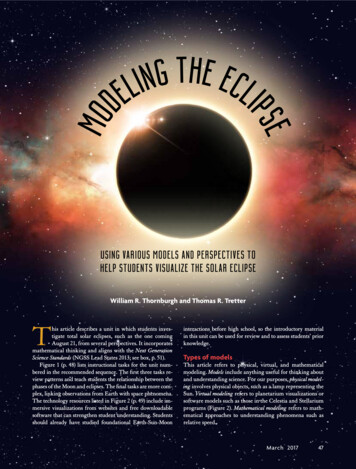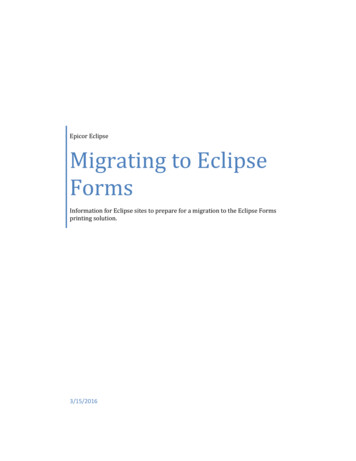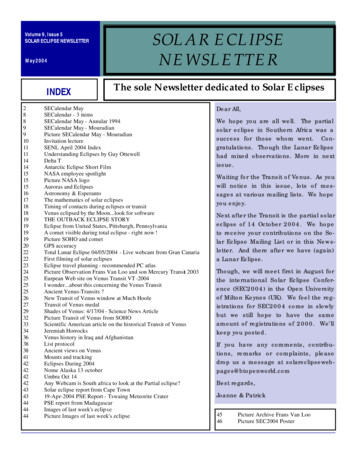
Transcription
Volume 9, Issue 5SOLAR ECLIPSE NEWSLETTERMay SOLAR ECLIPSENEWSLETTERThe sole Newsletter dedicated to Solar EclipsesSECalendar MaySECalendar - 3 itemsSECalendar May - Annular 1994SECalendar May - MouradianPicture SECalendar May - MouradianInvitation lectureSENL April 2004 IndexUnderstanding Eclipses by Guy OttewellDelta TAntarctic Eclipse Short FilmNASA employee spotlightPicture NASA logoAuroras and EclipsesAstronomy & EsperantoThe mathematics of solar eclipsesTiming of contacts during eclipses or transitVenus eclipsed by the Moon.look for softwareTHE OUTBACK ECLIPSE STORYEclipse from United States, Pittsburgh, PennsylvaniaA comet visible during total eclipse - right now !Picture SOHO and cometGPS accuracyTotal Lunar Eclipse 04/05/2004 - Live webcam from Gran CanariaFirst filming of solar eclipsesEclipse travel planning - recommended PC atlasPicture Observation Frans Van Loo and son Mercury Transit 2003Eurpean Web site on Venus Transit VT -2004I wonder.about this concerning the Venus TransitAncient Venus-Transits ?New Transit of Venus window at Much HooleTransit of Venus medalShades of Venus: 4/17/04 - Science News ArticlePicture Transit of Venus from SOHOScientific American article on the historical Transit of VenusJeremiah HorrocksVenus history in Iraq and AfghanistanList protocolAncient views on VenusMounts and trackingEclipses During 2004Nome Alaska 13 octoberUmbra Oct 14Any Webcam is South africa to look at the Partial eclipse?Solar eclipse report from Cape Town19-Apr-2004 PSE Report - Tswaing Meteorite CraterPSE report from MadagascarImages of last week's eclipsePicture Images of last week's eclipseDear All,We hope you are all well. The partialsolar eclipse in Southern Africa was asuccess for those whom went. Congratulations. Though the Lunar Eclipsehad mixed observations. More in nextissue.Waiting for the Transit of Venus. As youwill notice in this issue, lots of messages at various mailing lists. We hopeyou enjoy.Next after the Transit is the partial solareclipse of 14 October 2004. We hopeto receive your contributions on the Solar Eclipse Mailing List or in this Newsletter. And there after we have (again)a Lunar Eclipse.Though, we will meet first in August forthe international Solar Eclipse Conference (SEC2004) in the Open Universityof Milton Keynes (UK). We feel the registrations for SEC2004 come in slowlybut we still hope to have the sameamount of registrations of 2000. We’llkeep you posted.If you have any comments, contributions, remarks or complaints, pleasedrop us a message at solareclipsewebpages@btopenworld.comBest regards,Joanne & Patrick4546Picture Archive Frans Van LooPicture SEC2004 Poster
Volume 9, Issue 5SOLAR ECLIPSE NEWSLETTERPage 2SECalendarMay 2004Dear All,Please find herewith the solar eclipse calendar (SECalendar) for May. If you haveany additional information, queries or remarks, please drop us a mail.For the whole Solar Eclipse Calendar, see our Solar Eclipse WebPages mMay 01, 0664 "In this year the Sun was eclipsed on the 5th of the Nones of May; and Earcenbryht, the King of the Kentish peopledied and Ecgbryht his son succeeded to the Kingdom." Refers to the total solar eclipse of 1 May AD 664. From: The Anglo SaxonChronicles. Ref SW Solar Eclipses from Year 1.May 01, 1185 "On the first day of the month of May, on the day of the Saint Prophet Jeremiah, on Wednesday, during the eveningservice, there was a sign in the Sun. It became very dark, even the stars could be seen; it seemed to men as if everything were green,and the Sun became like a crescent of the Moon, from the horns of which a glow similar to that of red-hoot charcoals was emanating. It was terrible to see this sign of the Lord." From: Lavrentievskaya Letopis. "On the first day of the month of May, during theringing of the bells for the evening service, there was a sign in the Sun. It became very dark for an hour or longer and the stars werevisible and to men everything seemed as if it were green. The Sun became like a crescent of the new Moon and from its horns aglow like a roasting fire was coming forth and it was terrible to see the sign of the Lord. Then the Sun cleared and we were happyagain." From: Novgorodskaya II Letopis Both of these quotations refer to a total solar eclipse in Novgorod, Russia, of 1 May 1185.Ref. FRS 1997, page 395.May 01, 1952 Minor planet (3428) Roberts 1952 JH. Discovered 1952 May 1 at the Goethe Link Observatory at Brooklyn, Indiana.Named in memory of Walter Orr Roberts (1915-1990), from 1960 to 1970 the founding director of the National Center for Atmo spheric Research. In the early 1940s he established the Harvard College Observatory's Fremont Pass Station (which later became theUniversity of Colorado's High Altitude Observatory), where he made solar observations with the first coronagraph in the westernhemisphere. His interests soon broadened from solar physics to climatic research in general, and he served as president (and laterpresident emeritus) of the University Corporation for Atmospheric Research. His final major activity was the Greenhouse Gla snostproject between scientists in the U.S. and the U.S.S.R. (M 16885) Name proposed by F. K. Edmondson. Obituaries published inBill. Am. Astron. Soc., Vol. 24, No. 4, p. 1331-1332 (1992); Q.J.R. Astron. Soc., Vol. 33, No. 1, p. 35-37 (1992). Dictionary of M inor Planet Names - ISBN 3-540-14814-0 - Copyright 1999 by Springer-Verlag Berlin HeidelbergMay 03, -1374 (1375 BC) Syria: A clay tablet found at that site notes that "the day of the New Moon in the month of (Apr-May)was put to shame. The sun went down with Mars in attendance. This means the overlord will be attacked by his vassals." Ulysses3/97" But: "was put to shame" was also translated as "on the sixth" (day) and again differently by others. "went down" is the sameword as that used for "to set". Ref. ENB013. This is no solar eclipse, although mentioned by several references. (Reprinted, fromChasing the Shadow, copyright 1994 by Joel K Harris and Richard L Talcott, by permission of Kalmbach Publishing Co. Also appears in Total Eclipses of the Sun by Zirker. In Guide to the Sun, Phillips says that this might refer to the eclipse of 1223 BC.) Ref.SENL July 1999, FE 01/01.May 03, 1715 "A few seconds before the sun was all hid, there discovered itself round the mo on a luminous ring about a digit, orperhaps a tenth part of the moon's diameter, in breadth. It was of a pale whiteness, or rather pearl-colour, seeming to me a littletinged with the colors of the iris, and to be concentric with the moon." Refers to a total solar eclipse of 3 May 1715. From: EdmundHalley. Ref. Popular Astronomy by Newcomb, and in UK Solar Eclipses from Year 1 by Williams.May 03, 1715 Edmond Halley (1656-1742 or 1743) England, during an eclipse in England, is the first to report the phenomenonlater known as Baily's Beads; also notes bright red prominences and the east-west asymmetry in the corona, which he attributes to anatmosphere on the Moon or Sun. Halley observed from London (John Flamsteed (1646-1719) observed from Greenwich).(Continued on page 3)
Volume 9, Issue 5SOLAR ECLIPSE NEWSLETTERPage 3SECalendarMay 03, 1715 Probably the first map of a path of totality, drawn by the English astronomer Edmond Halley (1656-1742 or 1743).On a copper plate he engraved the totally paths of the total solar eclipses of 3 May 1715 and 11 May 1724. On top of the map, thedate 22 April 1705 (i.o. 3 May) is mentioned, but that is because the Gregorian Calendar in England was introduced in 1752.May 03, 1769 "It will be Eclipse first, the rest nowhere." Dennis O'Kelly (at Epsom, 3 May 1769) (Quoted in The Penguin Dic tionary of Quotations by Cohen and Cohen. In UK Solar Eclipses from Year 1, Sheridan Williams says: "One of the world's mostsuccessful racehorses was born around the time of this [annular eclipse of 1 April 1764] and was named Eclipse. The Eclipse Stakes,named after that horse, are still run today, and the horse of the year awards in the U.S. are called Eclipse Awards after him.")May 03, 1880 Death of Jonathan H. Lane, American physics and astronomer. Studied temperature and physics of the Sun and density of Sungas.May 03, 1981 Hess 2844 (1981 JP): Minor planet discovered May 03, 1981 by Edward L.G. Bowell at Anderson Mesa. Named inhonor of Frederick Hess, Prof. of natural sciences at the State Univ. of NY at Fort Schuyler and long time lecturer at the HaydenPlanetarium-American Museum in NYC. Hess has directed a number of Solar Eclipse expedition and has accumulated more than 30min in the shadow of the Moon. MPC 9215. Name proposed by the discoverer. Ref. VK6/97May 04, 0292 Last total solar eclipse visible in Madeira. The next total solar eclipse in Madeira will be only in 18 September 2620.On 15 May 291 there was a total solar eclipse though, only a year before. A nearly miss with magnitude 0.99 was on 20 June 540and a total solar eclipse before sunrise, (altitude -1) on 17 October 1781. Ref. More Mathematical Astronomical Morsels by JeanMeeus; Willmann-Bell, 2002.May 05, 0840 "In the third year of the Indiction, the Sun was hidden from this world and stars appeared in the sky as if it were midnight, on the third day before the Nones of May (May 5) during the Litanies of Our Lord. There was great distress, and while thepeople beheld it, many thought that this age would last no longer. But while they were contemplating these simple things, the Sunshone again and trembling as it were began to escape from its former shade." Refers to a total solar eclipse of 5 May AD 840.From: Andreas Bergomatis Chronicon. Ref. FRS 1997, page 387.May 05, 1361 " Chih-cheng reign period, 21st year, 4th month, day hsin-szu, the first day of the month. As the Sun was about tosink (i.e. set) suddenly it lost its light. It took the shape of a plantain leaf. The sky was as dark as night and the stars were shiningbrightly. For a short time (literally: for the duration of a meal)., the sky became bright again. Then in a short time (the light) disappeared once more." Refers to a total solar eclipse of 5 May 1361. From: Sung-chiang Fu-chih (History of the town of Sung-chiang,south-west of Shanghai). Ref. FRS 1997, page 259.May 06, 1883 Carolina 235: Minor planet discovered 1883 November 28 by Johann Palisa at Vienna. Named for an atoll of theLine Islands, 450 miles northwest of Papeete, Tahiti, where the discoverer observed the Total Solar Eclipse of May 6, 1883. Palisaobserved the solar neighborhood in order to find an intra-Mercurian planet. BAJ CIR 218. Ref. VK 6/97May 06, 1883 Oceana 224: Minor planet discovered 1882 March 30 by Johann Palisa at Vienna. Na med for the Pacific Ocean.The discoverer communicated from Honolulu on return from the solar eclipse expedition of May 6, 1883 that Governor von Dessartsof Tahiti has named this planet. BAJ CIR 210 (1883). Ref. VK 6/97May 07, 1819 Birth of Otto Wilhelm von Struve (1819-1905) in Dorpat, Russian astronomer. Discovered 547 double stars, studiedrings of Saturn and parallax of the Sun.May 09, 1988 Minor planet (4899) Candace 1988 JU. Discovered 1988 May 9 by C. S. Shoemaker and E. M. Shoemaker at Palomar. Named for Candace P. Kohl, American chemist and a leading investigator of ancient solar activity through analysis of solarcosmic-ray-produced nuclides in lunar samples. She has also contributed importantly in the development of techniques for datingsurface exposure of materials on the earth from cosmic-ray-produced nuclides. Through her popular lectures on meteorites, themoon and the solar system, Kohl has reached a wide audience ranging from primary-school children to high-school students and thelay community. (M 25443) Citation provided by K. Nishiizumi at the request of the discoverers. Dictionary of Minor PlanetNames - ISBN 3-540-14814-0 - Copyright 1999 by Springer-Verlag Berlin Heidelberg(Continued on page 4)
Volume 9, Issue 5SOLAR ECLIPSE NEWSLETTERPage 4SECalendar(Continued from page 3)May 11, 1904 Minor Planet (536) Merapi Discovered 1904 May 11 by G. H. Peters at Washington. Named after a mountain inwest central Sumatra, site of the U.S. Naval Observatory and other expeditions to the total solar eclipse of May 17, 1901. It gives offsmoke more or less continuously and the name means "with fire". It should not to be confused with the nearby active volcano of thesame name in central Java. The discoverer was a member of the eclipse expedition. (H 57) Dictionary of Minor Planet Names ISBN 3-540-14814-0 - Copyright 1999 by Springer-Verlag Berlin HeidelbergMay 11, 1916 Death of Karl Schwarzschild, German astronomer. Explained the difference in light intensity of the edge of the Sunin 1906.May 11, 1924 Birth of Antony Hewish, British physicist and astronomer. Studied Solarwind. Got Nobelprice of physics in 1974.May 11, 1956 Death of Walter S. Adams, American astronomer. Studied spectra of Sunspots and stars.May 12, 1706 An English ship captain named Stannyan, on vacation in Switzerland, reports a reddish streak (chromosphere? prominence?) along the rim of the Sun as the eclipse becomes total.May 12, 1706 If Duillier's account is to be trusted, the Moon's shadow was first seen in its swift approach. (ref. Total E of the S,Todd, 1894). "This was also the occasion when, if DUILLIER'S account is to be trusted, the Moon's shadow was first seen in itsswift approach." (p 110)May 13, 1733 As per (Sir) Patrick Moore, Guiness Book of Astronomy (1983), the shadow bands have been reported for the firsttime by H. Goldschmidt in 1820. The description is also mentioned in the book of Mabel Todd, Total Eclipses of the Sun, 1894.But during the total solar eclipse of 13 May 1733 (2 May 1733 Julian date), observations have been coordinated and collected byCelsius. The eclipse was visible in the north of Europe. In Forsheim, Sweden, the duration was a little more then 3 minutes. TheTransactions of the Royal Society of Sweden do have the most physical nature observations of a solar eclipse of that time and before. Edmond Halley (1656-1742 or 1743) was the only whom noted a physical observation during the eclipse of 1715. Rydhenius,pastor of Forshem noted following: when the sun was about to lose his light, and also when he was about to recover it, he emittedrays that undulated like the aurora borealis, and were of a fiery red color. At the same eclipse, the pastor of Flo noted: towards thetotal obscuration stars were visible, and also a singular fluctuation in the air. (ref. History of Physical Astronomy)May 13, 1733 Birger Wassenius (Sweden), observing an eclipse near Göteborg, is the first to report prominences visible to the unaided eye; he attributes them to the Moon.May 13, 1733 The first person who makes mention of earthshine during totality is Bigerus Vassenius the Swedish astronomer. Inthe account of that eclipse which he transmitted to the royal Society, he asserts that with the telescope of 21 feet focal length, he perceived several of the principal spots on the moon during the total obscuration. Ferrer also states, that during the total eclipse of1806, the irregulations of the moon's surface were plainly discernible. (ref. History of Physical Astronomy).May 13, 2608 November 15, 1999 last transit of Mercury which was partial for a region though complete in parts of Australia andNew Zealand (Patrick Poitevin observed from Invercargill in New Zealand). Line between the area of complete transit and that ofpartial transit crossed Australia and New Zealand. The next transit of Mercury which was partial for a region was on 13 May 2608.This transit is partial in area's and in other area's no transit at all. Ref. More Mathematical Astronomical Morsels by Jean Meeus.May 14, 1230 "On the 14th May, which was the Tuesday in Rogation Week, the unusual eclipse of the Sun took place very early inthe morning, immediately after sunrise; and it became so dark that the labourers, who had commenced their morning's work, wereobliged to leave it, and returned again to their beds to sleep; but in about an hour's time, to the astonishment of many, the Sun regained its usual brightness." Refers to the total solar eclipse of 14 May 1230. From: Rogerus de Wendover, Flores Historiarum, vol.ii. p.235. Ref. FRS 1997, 425.May 14, 1973 Launch of Skylab, American spaceship. Got 3 times visitors of each time 3 astronauts. Research of the sun.May 14, 1991 Minor Planet 5381) Sekhmet 1991 JY. Discovered 1991 May 14 by C. S. Shoemaker at Palomar. The daughter of(Continued on page 5)
Volume 9, Issue 5SOLAR ECLIPSE NEWSLETTERPage 5SECalendarthe Egyptian god Ra and wife of Ptah {see planets (2100) and (5011), respectively}, Sekhmet was a lion-headed sun goddess. Herrole was that as defender of the divine order, not as creator of it. Her title was the "Mighty One", and she was a fierce goddess ofwar and strife and bringer of destruction to the enemies of Ra. She was considered the Eye of Ra, representing the scorching, destructive power of the sun. (M 24917) Dictionary of Minor Planet Names - ISBN 3-540-14814-0 - Copyright 1999 by SpringerVerlag Berlin HeidelbergMay 15, 1836 Francis Baily (1774-1844) UK, during an annular eclipse in Scotland, calls attention to the brief bright beads of lightthat appear close to totality as the Sun's disk is blocked except for the sunlight streaming through lunar valleys along the limb. Thisphenomenon becomes known as Baily's Beads.May 15, 1921 First record of Aurora Borealis observation during day time? Aurora have been seen in New Zealand and surrounding islands. September 18, 1941, in the north, Michigan, Aurora Borealis have been reordered during daytime. (ref. SaT 3/1954 and12/1953)May 17, 1836 Sir Joseph Norman Lockyer (1836-1920), British physicist and astronomer was born at Rugby on May, 17th 1836 toMr. Joseph Hooley Lockyer, a lecturer on scientific subjects at Rugby School and his wife Anne Norman. Sir Joseph NormanLockyer (1836-1920) founded the magazine Nature in 1869. Observed the sun and discovered one unknown line in the spectra: helium. Observed 8 total solar eclipses. Passed away August 16, 1920 in Salcombe Regis, Devon England. Ref. Bibliography of Astronomers by Paul Luther, 1989.May 17, 1882 A comet is discovered and photographed by Sir Arthur Schuster (1851-1934), Germany/UK, during an eclipse inEgypt: first time a comet discovered in this way has been photographed. The Total Solar Eclipse had been observed by Sir JosephNorman Lockyer (1836-1920), Ranard and Schuster from England, Tacchini from Italy, Trépied, Thollon and Puiseux from France.Observation from Sohag at the Nile.May 18, -0602 (603 Bc) ". . . there was war between the Lydians and the Medes five years. . . . They were still warring with equalsuccess, when it chanced, at an encounter which happened in the sixth year, that during the battle the day turned to night. Thales ofMiletus had foretold this loss of daylight to the Ionians, fixing it within the year in which the change did indeed happen. So when theLydians and Medes saw the day turned to night, they ceased from fighting, and both were the more zealous to make peace." Probably refers to the total solar eclipse of 28 May 585 BC in Asia Minor. Herodotus, (c485-c420 BC) History I, 74. Quoted in HistoricalEclipses and Earth's Rotation, by F Richard Stephenson, Cambridge University Press, 1997, page 242. Also in Greek Astronomy byHeath, and in Total Eclipses of the Sun, by Zirker, and referred to in The Fontana History of Astronomy and Cosmology by North.The Encyclopaedia Britannica CD 98 says that this eclipse must have been predicted by means of the Saros and the eclipse of 18May 603 BC. Ref FE 01/01May 18, 1901 Merapi 536: Minor planet discovered 1904 May 11 by G. H. Peters at Washington. Named after a mountain in westcentral Sumatra, site of the U.S. Naval Obs and other expeditions to the Solar
May 04, 0292 Last total solar eclipse visible in Madeira. The next total solar eclipse in Madeira will be only in 18 September 2620. On 15 May 291 there was a total solar eclipse though, only a year before. A nearly miss with magnitude 0.99 was on 20 June 540 and a total solar eclip

